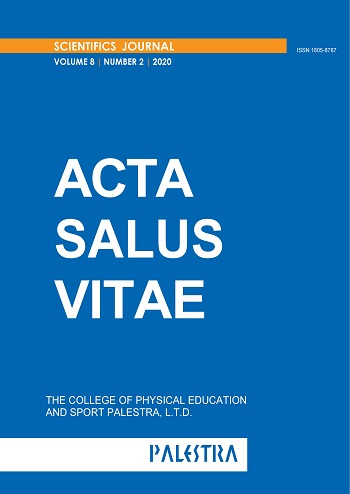Homeostasis and balance in senium
DOI:
https://doi.org/10.58743/asv2020vol8no2.240Keywords:
Homeodynamics; Elderly; Circadian rhythms; Balance changes; Health.Abstract
The body's homeostasis ensures the individual's survival in a constantly changing environment, such as changes and fluctuations of temperature, humidity, pressure, etc. The central nervous system and cardiovascular system play a priority in maintaining homeostasis. State of balance is closely related to the theory of homeostasis and homedynamics, where the term homeostasis is characterized as the tendency of the organism to a relatively stable balance between interdependent elements maintained by physiological processes. The study is aimed on content and descriptive analysis of the context of homeostasis, homeodynamics and bio-psycho-social balance in aging in frame of the GAČR project ID 17-25710S “Basic research of balance changes in seniors”. Methods of content and descriptive analysis were used as a base. There is experimental evidence that various forms of stress, especially when severe or recurrent, can induce corresponding structural and neurochemical or neurophysiological changes in the neural and glial networks. It can be assumed that many of these stress-induced structural and functional changes in the CNS may cause the development of some neuropsychiatric disorders typical of old age. According to yoga practice, it is known that many of these changes are reversible with sufficient recovery time.
References
Carnes, BA. What is lifespan regulation and why does it exist? Biogerontology 2011; 12: 367-74.
Fulop, T, Larbi, A, Witkowski, JM, et al. Aging, frailty and age related diseases. Biogerontology 2010; 11: 547-63.
Hill, M., Třískala, Z., Honců, P., Krejčí, M., Kajzar, J., Bičíková, M., Ondřejíková, L., Jandova, D., Sterzl, I. (2020) Aging, Hormones and Receptors. Physiological Research 69 (Suppl. 2): pp. 255-272. https://doi.org/10.33549/physiolres.934523
Holliday, R. (2006) Aging is no longer an unsolved problem in biology. Annals of the New York Academy of Sciences 1067: 1-9.
Jandová, D. (2020) Senium a jeho fáze z pohledu medicíny. In Krejčí, M. et al (2020). Základní výzkum změn rovnováhy seniorů. Praha: Vysoká škola tělesné výchovy a sportu Palestra. 63-75.
Krejčí, M., Hošek, V. et al. (2016) Wellness. Praha, Grada.
Krejčí, M., Psotta, R., Hill, M., Kajzar, J., Jandová, D., Hošek, V. (2020) A short-term yoga-based intervention improves balance control, body composition, and some aspects of mental health in the elderly men. Acta Gymnica, 50, (1) 16–27. DOI: 10.5507/ag.2020.004
Lloyd, D, Aon, MA, Cortassa, S. (2001) Why homeodynamics, not homeostasis? Scientific World Journal. 4(1) 133-45. doi: 10.1100/tsw.2001.20. PMID: 12805697; PMCID: PMC6084724
Rattan SIS (2014) Molecular Gerontology: From Homeodynamics to Hormesis. Current Pharmaceutical Design, 20(18) 3036-3039.
Rattan, SIS. (2006) Theories of biological aging: genes, proteins and free radicals. Free Radical Research, 40: 1230-8.
Rattan, SIS. (2008) Increased molecular damage and heterogeneity as the basis of aging. Biological Chemistry 389: 267-72.
Rattan, SIS. (2012) Biogerontology: from here to where? The Lord Cohen Medal Lecture-2011. Biogerontology 13: 83-91.
Yoshida, H. (2007) ER stress and diseases. Federation of European Biochemical Societies Journal 274: 630-58.
Downloads
Published
How to Cite
Issue
Section
License
Copyright (c) 2021 Milada KREJČÍ, Dobroslava JANDOVÁ

This work is licensed under a Creative Commons Attribution 4.0 International License.
Authors publishing in this journal agree to the following terms:
Authors retain copyright and grant the journal the right of first publication, while the work is also licensed under the Creative Commons Attribution License, which allows others to share this work acknowledging its author and initial publication in this journal.
Authors are permitted to enter into separate, additional contractual arrangements for the non-exclusive distribution of the work in the version published in the journal (for example, to publish it in a book), with an acknowledgement of its initial publication in this journal.
Authors are allowed and encouraged to share their work online (for example, on their websites) before and during the editorial process of their contribution, as such a practice can lead to productive exchanges of ideas and also earlier and higher citation of the published work (See the Open Access Effect).


